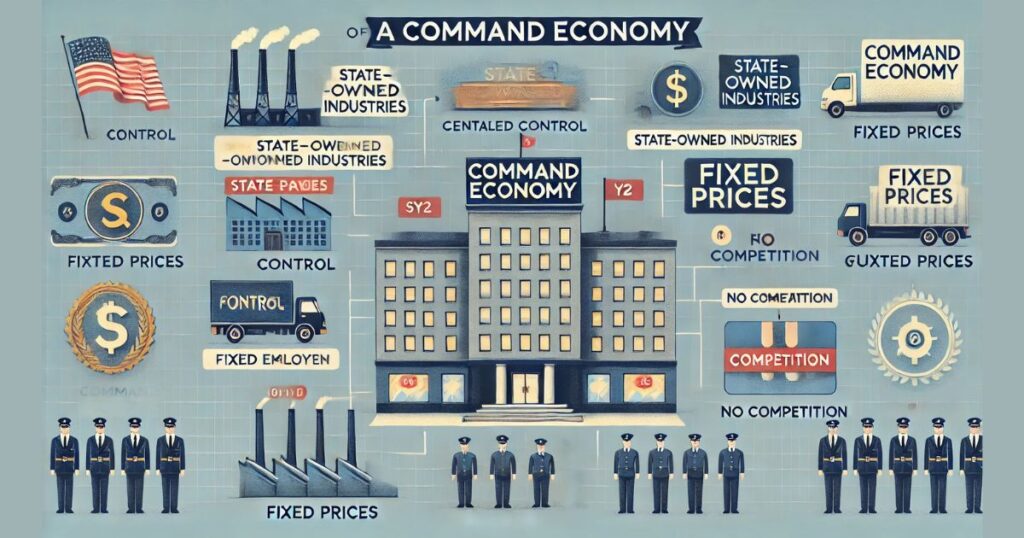
A command economy is a system in which a central authority, typically the government, takes full control of economic activities, determining production, distribution, and pricing. This type of economy is designed to achieve specific societal goals, such as equal wealth distribution or rapid industrialization. Command economies often exist in countries with a centralized government that prioritizes control over market forces.
In this article, we will provide a comprehensive overview of command economies, explaining their characteristics, mechanisms, advantages, disadvantages, and examples from history and the modern era.
What is a Command Economy?
A command economy is an economic system where all major economic decisions are made by a central authority. Unlike market economies that rely on supply and demand to allocate resources, command economies operate based on predetermined plans. In such systems, the government dictates what goods and services will be produced, in what quantities, and at what prices.
Command economies are typically found in societies striving for collective welfare over individual profit. They aim to reduce inequality by redistributing resources and controlling industries deemed vital to national interests.
How Does a Command Economy Work?

In a command economy, the government creates detailed economic plans outlining goals for production and distribution. These plans are often divided into short-term and long-term objectives. Here’s a breakdown of how a command economy functions:
1. Centralized Decision-Making
The government, acting as the central authority, decides the allocation of resources, including labor, raw materials, and capital. Ministries and agencies oversee specific sectors of the economy, ensuring compliance with the national plan.
2. Production Targets
Specific production quotas are set for industries and enterprises. For example, a steel plant may be required to produce a certain number of tons of steel annually, regardless of market demand.
3. Price Controls
Prices are fixed by the government to ensure affordability and eliminate competition. This prevents price fluctuation but can lead to inefficiencies.
4. State Ownership
In most command economies, key industries such as energy, healthcare, and transportation are state-owned. This ensures that profits are reinvested into public welfare.
5. Resource Allocation
The government determines the distribution of goods and services. Resources are often prioritized for sectors deemed essential for economic development, such as heavy industry or agriculture.
Key Characteristics of a Command Economy

1. Centralized Authority
All economic decisions are made by a single governing body, ensuring uniformity in policy implementation.
2. Absence of Competition
Since the government controls production and pricing, private businesses either do not exist or operate under strict regulations.
3. Focus on Collective Goals
Command economies prioritize societal goals, such as reducing unemployment, increasing literacy rates, or achieving rapid industrialization.
4. Fixed Pricing
Prices are set by the government, eliminating market-driven price changes. While this ensures stability, it often leads to shortages or surpluses.
5. Limited Consumer Choice
With production focused on fulfilling quotas, consumer preferences take a backseat, resulting in fewer options for goods and services.
Advantages of a Command Economy
1. Economic Stability
By controlling prices and production, command economies minimize the volatility often seen in market economies. This creates a stable economic environment.
2. Focus on Equality
Command economies aim to reduce income inequality by redistributing wealth and resources evenly across the population.
3. Rapid Industrialization
Government-directed investment in infrastructure and industry can lead to rapid economic development, particularly in emerging economies.
4. Guaranteed Employment
With the government in control, employment can be allocated efficiently, ensuring jobs for the majority of the population.
5. Crisis Management
In times of war or natural disasters, command economies can quickly redirect resources to address immediate needs.
Disadvantages of a Command Economy
1. Lack of Innovation
Without competition or profit incentives, there is little motivation for businesses to innovate or improve efficiency.
2. Inefficiency
Centralized planning often leads to misallocation of resources, resulting in overproduction of some goods and shortages of others.
3. Bureaucratic Delays
The layers of bureaucracy involved in planning and implementation can slow decision-making, reducing responsiveness to economic changes.
4. Limited Consumer Freedom
Consumers in command economies have fewer choices as production is driven by government priorities rather than market demand.
5. Risk of Corruption
Centralized control increases the likelihood of corruption and misuse of power, as decisions are concentrated in the hands of a few.
Examples of Command Economies
Historical Examples
- Soviet Union: The USSR operated a command economy for much of the 20th century, emphasizing heavy industry and collectivized agriculture.
- China: Before transitioning to a mixed economy, China followed strict command economy principles under Mao Zedong.
Modern-Day Examples
- North Korea: A rigid command economy with state control over all industries and resources.
- Cuba: While introducing some market reforms, Cuba remains largely a command economy with significant government involvement.
Command Economy vs. Market Economy
A market economy contrasts sharply with a command economy. In market economies, supply and demand drive production and pricing decisions. Private ownership and competition are central to their functioning, fostering innovation and efficiency. On the other hand, command economies focus on equality and collective welfare, often at the expense of individual freedom and market efficiency.
Conclusion
A command economy represents a centralized approach to managing economic activities, prioritizing societal goals over market-driven forces. While it offers advantages such as stability and equality, it also comes with challenges like inefficiency and limited consumer choice. Understanding the dynamics of a command economy helps us appreciate its role in shaping the global economic landscape.
If you want to read more information about how to boost traffic on your Website just visit –> The Insider’s Views.






